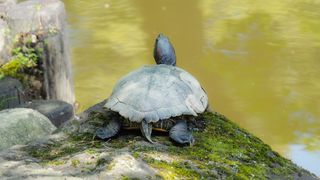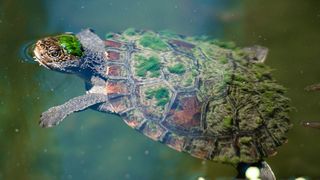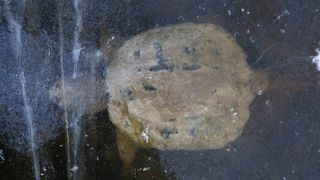Can turtles really breathe through their ass?
Everyone knows that most mammals breathe through the mouth and nose. Frogs, meanwhile, can breathe through their skin. But what about turtles? How do these hard-shelled creatures get oxygen?
You may have heard the strange rumor that turtles can breathe through their bottoms. But is this true?
Technically, turtles don’t breathe through their derrières. That’s because turtles don’t really have “butts”; instead, they have a versatile opening known as the cloaca, which is used for sexual reproduction and egg laying as well as for excreting feces. However, they are involved in a process called cloacal respiration, which in a less technical sense can be interpreted as “butt-breathing”.
During cloacal respiration, turtles pump water through their cloacal openings and into two sac-like organs known as bursae, which act like water. lungs, Craig Franklin, a wildlife physiologist at The University of Queensland in Australia who has studied cloacal breathing extensively, told Live Science. The oxygen in the water then diffuses across the papillae, tiny structures that line the walls of the bursa, and into the turtle’s bloodstream.
Related: Why do turtles live so long?
However, cloacal respiration is very inefficient compared to normal aerobic respiration, and all turtles also have the capacity to inhale air with their lungs more easily. As a result, cloacal respiration has only been seen in a small number of freshwater species that rely on this unusual method to overcome the challenges they face in unique environments where it is difficult to breathe air, such as fast-flowing rivers or frozen ponds.
Cloacal champion
The main group of turtles that completely control cloacal respiration is the river turtles. Globally, there are about a dozen river turtles that make good use of cloacal respiration, about half of which live in Australian rivers; These include Mary River turtles (Elusor macrorus) and the white-throated snapping turtle (Elseya albagula), said Franklin.
However, some river turtle species are much better at cloacal respiration than others. The undisputed champion is the Fitzroy River turtle (Rheodytes leukops) from Australia, which can obtain 100% of its energy through cloacal respiration. “This allows them to potentially remain underwater indefinitely,” Franklin said.
But for all other species, cloacal respiration only prolongs the amount of time they can stay underwater until they have to resurface for air. “For example, instead of diving underwater for 15 minutes [while holding their breath]they can stay underwater for several hours,” he said.
The ability to stay underwater for long periods of time is especially useful for river turtles as rising to the surface can be hard work. “For turtles that live in fast-flowing water, going to the surface to breathe is a bit of a problem because you can drift away,” Franklin said. Being close to the riverbed also makes it easier to avoid predators such as crocodiles, he added.
(opens in a new tab)
Avoiding predators is especially important for baby turtles, which can be targets for birds and large fish. “The greatest risk of predation for hatched turtles is swimming through the water column to the surface,” Franklin said. As a result, juveniles are usually much better at cloacal respiration than adults, which allows them to spend more time near the riverbed until they are old enough to begin venturing to the surface more frequently. Therefore, it is possible that additional river turtle species were also capable of cloacal respiration as juveniles but then lost this ability later in life, Franklin said.
However, cloacal respiration is much less efficient than aerobic respiration because pumping water into the bursa requires a lot of energy, which reduces the net gain from energy the turtle receives. “When we breathe air, almost no energy is needed” because gas light and flows freely in and out of our lungs, says Franklin. “But imagine trying to inhale the viscous liquid back and forth.” Water also has about 200 times less oxygen than the same volume of air, so turtles have to pump more to get the same amount of oxygen, he added.
Related: How do animals breathe underwater?
There are also other costs for cloacal respiration. When oxygen diffuses across the skin bursa and into the bloodstream, sodium and chloride ions (charged particles) within the papillae, which are essential for the function of cell, diffuses in the opposite direction into the water, which stops the cells from functioning properly. To combat this, turtles have developed special pumps that suck the lost ions back into the cells to maintain normal ion levels. This process, known as osmoregulation, requires additional energy, thereby further reducing the net energy gain from cloacal respiration.
Stuck under the ice
(opens in a new tab)
There are also about six or seven species of freshwater turtles hibernating throughout North America that are capable of more restricted form of cloacal respiration. These species, such as the Blanding tortoise (Emydoidea bladingii), spent months trapped under the permafrost that covered the pool for winter. Some of these turtles have been under the ice for more than 100 days without being able to breathe air, Jackie Litzgus, a wildlife ecologist at Laurentian University in Ontario, told Live Science. In contrast, these turtles can also take in oxygen through the bursae, as well as by gargling water down their throats, known as buccal pumping, Litzgus said.
However, the cloacal breathing exhibited by hibernating turtles is much more complex than river turtles can do, Franklin said. Instead of actively pumping water into their bursa like their river-dwelling relatives, hibernating turtles take in oxygen that passively diffuses across the skin in the bursa. This process is more like cutaneous respiration — when oxygen diffuses through animal skin, which occurs in amphibians, reptiles and, to a limited capacity, some mammals, including man.
Hibernating tortoises get away with this passive form of cloacal respiration because they have been greatly reduced metabolism levels, which means they require less energy and, therefore, less oxygen. When they are under the ice, these turtles don’t move much, guarding their bodies temperature near freezing point and can switch to anaerobic respiration — a last-ditch effort to create energy without oxygen — when oxygen is low, Litzgus said.
Originally published in Live Science.
#turtles #breathe #ass



Comments
Post a Comment